
3D Fabricators
Copyright © by V. Miszalok, last update: 2009-06-22

Let me know
what you think
| Home | Index of Lectures | << Prev | PDF Version of Page |
 |
3D Fabricators
|
 Let me know what you think |
| Objectives |
How to create 3D-models and implants ? |
| Summary |
|
SLA = fusing photopolymer liquid |
SLS = fusing powdered material |
FDM = extruding melted material |
3DP = ink jet printing |
LOM = multilayer. |
Displays just produce light, printers and plotters produce dots or lines on paper: input for human eyes.
Fabricators produce real massive objects: input for touch and mechanical contact.
They shape 3D-objects out of many sorts of raw material such as metals, solid and liquid synthetics, ceramics, metal powder, waste paper.
Stereolithography SLA
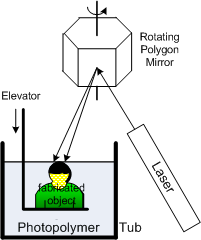 | Invented by Chuck Hall 1980. see: www.3dsystems.com/products/sla/index.asp Principle: Photo-sensitive polymers = photopolymers congeal when they are exposed to a laser beam. 3D-objects are laminated a layer at a time by tracing a laser beam on the surface of a vat of liquid photopolymer. The photopolymer is solidified by the laser light. Once one layer is completely traced, it is lowered a small distance into the liquid and a subsequent layer is traced, adhering to the previous layer. Some specific technologies require further curing of the polymer in an oven. CAD data of the product design is first sliced into very thin cross sections. A laser beam of ultraviolet light is then focused onto the surface of a vat of liquid photopolymer. The laser traces a cross section of the part, turning a thin layer of the liquid plastic to solid. The cross section is lowered and recoated with liquid photopolymer and the laser traces the next slice on top of the previous one. The process continues layer by layer until the part is complete. A three dimensional part is built within a matter of hours. |
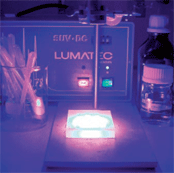 | 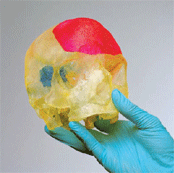 | 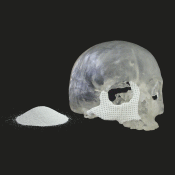 | Images from: www.3mat.de |
Selective Laser Sintering SLS
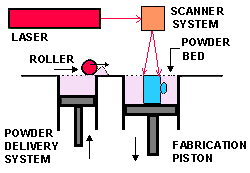 | Invented by R. Housholder 1979. SLS uses a high power carbon dioxide laser to fuse small particles of plastic, metal, or ceramic powders into a mass representing a desired 3-dimensional object. The laser selectively fuses powdered material by scanning cross-sections generated from a 3-D digital description of the part (e.g. from a CAD file or scan data) on the surface of a powder bed. After each cross-section is scanned, the powder bed is lowered by one layer thickness, a new layer of material is applied on top, and the process is repeated until the part is completed. Available powder materials: polymers (nylon, also glass-filled or with other fillers, and polystyrene), metals (steel, titanium, alloy mixtures and composites) and foundry sand. The physical process can be full melting, partial melting, or liquid-phase sintering. This and the following images from: Worldwide Guide to Rapid Prototyping |
Fused deposition modeling FDM
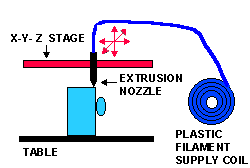 |
Invented by an unknown confectioner of layer cake and by S. Crump late 1980s. A plastic filament or metal wire is unwound from a coil and supplies material to an extrusion nozzle which can turn on and off the flow. The nozzle is heated to melt the material and can be moved in a plane above the object. materials: Acrylonitrile butadiene styrene (=ABS) polymers, polycarbonates, polyphenylsulfones and waxes. |
3D-Printing 3DP
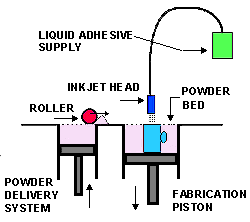 |
Invented at MIT in the late 1980s. 3DP uses adapted inkjet printing feeding fine powder or liquids into individual jetting heads which squirt tiny droplets as they are scanned to form a layer of the model. The liquid hardens after being deposited. Once a single layer has been deposited, a milling head may be employed to ensure uniform thickness before the next layer is deposited. The technique is typically very slow, but can obtain high resolution. Materials for spraying: glue, wax, starch, and photopolymer. Photopolymer machines employ an ultraviolet (UV) flood lamp mounted in the print head to cure each layer as it is deposited. 3DP is cheaper than SLA and SLS. |
Laminated Object Manufacturing LOM
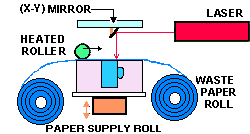 | Sheets of paper or plastic film are attached to previous layers by either sprayed glue, heating, or embedded adhesive, and then the desired outline of the layer is cut by laser or knife. Finished product typically looks and acts like wood. |
| top of page: |